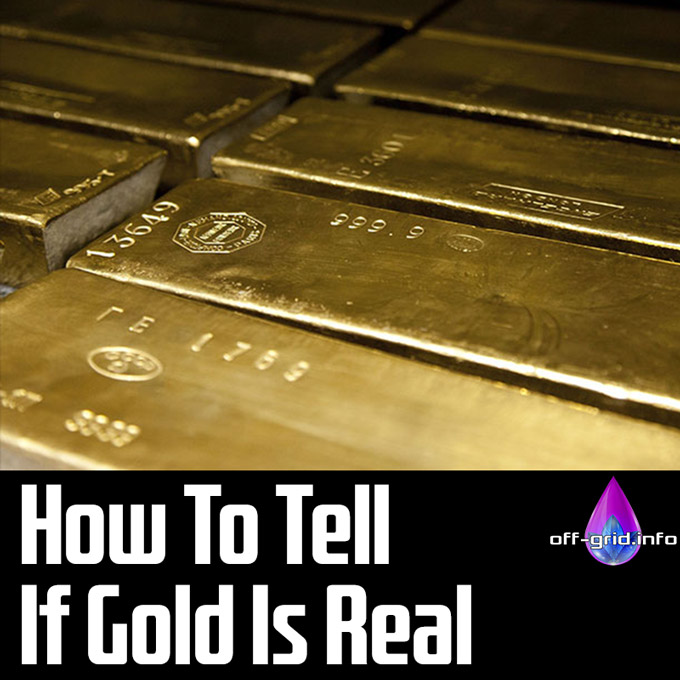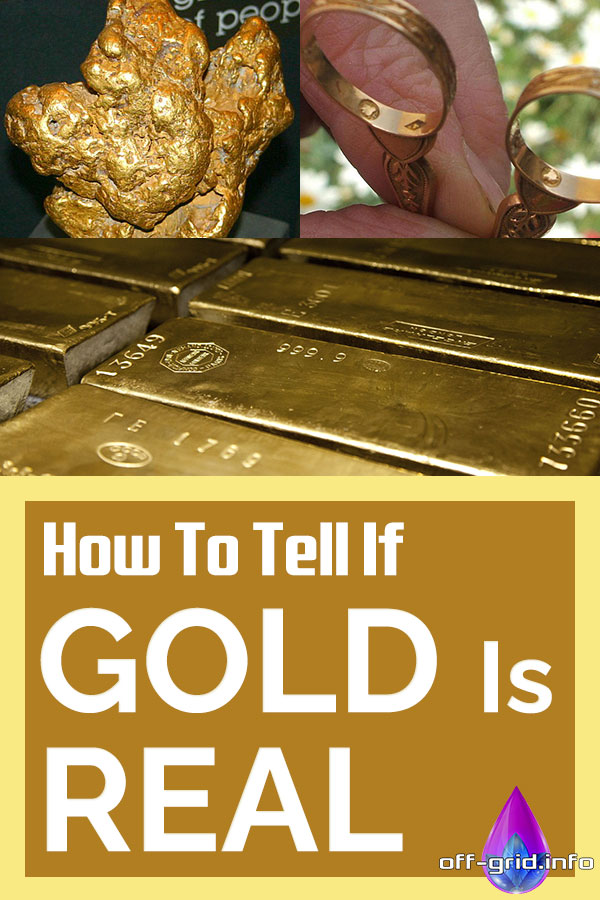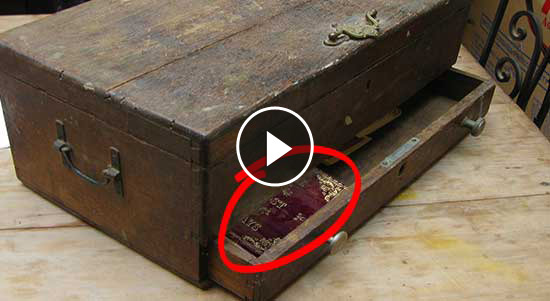Click Here To Join Our Telegram Channel for FREE daily tutorials!

How To Tell If Gold Is Real (Free In-Depth Tutorial!). Photo – PD
Introduction

Gold is an important topic to have some knowledge of if you are interested in investment, numismatics, prepping, survivalism and off-grid living related topics. If the grid goes down and electronic fund transfers cease, or if there is a run on the banks, then gold will be of paramount importance. Gold is still regarded as the most tangible, reliable and durable form of wealth in the world. It is portable, divisible, durable, does not rust or rot and can generally be bought or sold anywhere in the world.
There are many tests for gold and quite a few of them eliminate some but not all fakes: What is needed is a comprehensive resource and, depending on the circumstances, more than one type of test will be required. So with this page, we have attempted to build the “mother ship” – a giant list of all the possible ways to tell if gold is real, together with descriptions of their limitations. Bookmark this page and keep it as a reference for the future!
Of all the subjects one can possibly research online, the subject of how to tell if gold is real must rank as one of those highest in either misinformation or partial truth. To illustrate the misinformation and folly that is out there – I have even read one statement that if gold jewelry sinks in a bucket of water, it must be real! This is very obviously false – almost all metals are heavier than water.
Important note – if you are examining gold of considerable value, the best way of all to ascertain whether it is real is to take it to a reputable professional jeweler, bullion dealer or antiques dealer, or to contact an assay office (most countries have these). A good jeweler / antiques expert will have the training and the “lookup charts” to decode accurately hallmarks on jewelry. Also a reputable jeweler will have testing kits to evaluate gold and of course the expertise to test it without causing damage. A jeweler may of course charge a fee for this service.
For “serious” scenarios, contact an assay office. This is an institution specifically set up to test the purity of precious metals. It is only assay offices that are legally permitted to apply hallmarks to gold, platinum or silver items, guaranteeing their purity.
As assay offices may be considered the greatest masters of evaluating gold, it is instructive to observe their methods, as these will be the ones of greatest accuracy.
We will also look at simpler methods which may be applied at home, with consideration of their accuracy and usefulness.

Tests For Gold
The first thing to note is that some methods of evaluating gold are more destructive than others: If one has a piece of fine jewelry, one wants to use the least destructive method possible; whereas if one has raw metal, this factor is not quite as important.
Basic Observations
A few keen observations will often give some good initial hints as to the genuineness of gold:
Source: First, gold bullion bars will very often (but not always) come with an assay certificate guaranteeing their purity. It is also recommended to buy gold bullion of one of the well known brands (typically major banks or well known mints), through an established bullion dealer. If you are buying a valuable gold coin, inquire about the provenance. This is the history of where the coin was originally purchased or discovered. If it comes with authentication such as proof of purchase through a major auction house or coin dealer, that is very beneficial.
Very valuable coins are also often “slabbed” – which means encased in plastic with a certificate of authenticity issued by one of the professional coin grading services such as PCGS. This gives an additional layer of protection that is hard to fake; the code number on the certificate can be checked against the database of the grading service. Smaller denominations of gold bars may also be encased in this manner; here is an example of a PAMP Suisse Gold Bar that can be seen for sale on Amazon:

Weight: Although not an absolute test, solid gold is heavy. (It has a specific gravity of around 19.2). A gold plated copper, iron, brass or silver item will simply not have the same weighty feel to it. However lead and tungsten are both heavy metals and there have been (very rare) reports of gold bars being hollowed out and filled with one of these cheaper metals. Typically, if you have purchased through a reputable dealer this will almost certainly not happen, and you will have a warranty.
Age means nothing: Remember that in the world of coins, forgery is a very ancient art, once considered such a serious matter that it was actually punishable by death in the old days – yet it still went on. So the fact that a coin is, or appears to be, very old, does not in itself guarantee that it is genuine.
Price: Apply the obvious maxim that if something seems too good to be true, it probably is. Watch out for fake coins on ebay. These can be purchased on the open market from aliexpress.com – a good tip is to go to aliexpress and look at the fake coins that are for sale. You can then easily recognize that these are the fakes that come up on ebay; often they will use the exact same photo because they may even have the item sent directly from China, pocketing the difference in price. Let’s move on.
Hallmarks And Millesimal Fineness Marks
Hallmarks: Hallmarks are official marks applied to precious metal objects, denoting that their purity has been ascertained and approved. A true hallmark is not a manufacturer’s mark; it is the mark applied by the independent body or authority, typically at the national level:

Hallmarks on the inside surface of a gold item
The hallmark indicates that the item has been assayed. It is highly illegal to falsify a hallmark and penalties are severe. Fraudulent hallmarks are uncommon but technically a possibility so additional tests may be advisable in doubtful cases.
Hallmarks can be compared to hallmark charts (which can be found online) and they will give much information about the age of the item and its origins.
Examine any hallmarks and other mint marks closely, with a magnifying glass or jeweler’s loupe (Amazon Link) if possible. A genuine hallmark will have a professional appearance – evenly stamped and detailed, whereas a fake mark made from a cast will appear untidy and lack detail.
Millesimal fineness marks: Not all precious metal items will have hallmarks. In addition to / instead of hallmarks, you may see a millesimal fineness mark.
This will be a small (or even tiny, depending on the size of the item) stamp of a three-figure number, which denotes the purity in terms of “parts out of one thousand” of pure metal. Thus a millesimal fineness mark of 833 indicates the metal was 0.833 pure. To obtain the “carat” figure, multiply this number by 24. So 0.833 x 24 = 20 carat.
Unlike hallmarks, which may only be applied legally by a governing body, a millesimal fineness mark may legally be applied by the maker of the item and should be used strictly to denote the purity of metal used in its manufacture; though it is ultimately possible that this mark is fraudulent, therefore it is not an absolute guarantee of purity. It is useful, but other tests should still be applied.
Interestingly, the numbers applied to gold, silver and platinum are typically different.
The numbers 375, 585, 750, 833 or 917 denote that the item is indicated to be gold, at purity denoted by the number. You will also see gold bullion bars at 999, 999.9 or similar (more on this below).
Silver items (which were perhaps later gold plated in an attempt to pass them off as gold), may be marked with 800, 830, 835, 875 or 925. Note that if the item is marked “sterling” or 925, it is almost certainly sterling silver that has been gold plated.
Note also 958, which was a number applied to Britannia silver.
And finally 950; typically applied to platinum. It’s very unlikely that you would see platinum plated in gold and passed off as such, due to the fact that platinum is almost as expensive as gold.
Coin Weights
“Milled” coins minted in the modern era (since coin milling began in the 17th century) were of very precise weight, which can be ascertained by weighing. Note that if a coin is worn from circulation, the weight will be very slightly less than that of the uncirculated coin. Official coin weights can be obtained from coin collector catalogues and this is a simple test – if the weight is way off, then the coin is certainly fake. That does not necessarily mean that if it has the correct weight, it is genuine. But weight will weed out the majority of fakes, especially of gold and silver coins which are faked using cheap metals.
Precision scales can be obtained for very reasonable cost these days. Here is a 50g x 0.001g scale (weighs up to 50 grams at precision of 0.001 gram, which is more than sufficient for coin weighing!) I bought on Amazon for under $20 – and found to be very accurate. It comes with a 50-gram weight so that its precision can be tested prior to use. It is advisable also to obtain a very accurate set of precision weights so that these can be used to test scales at different weights on an ongoing basis.
Gold Bullion Bars
Gold Bullion Bars will be marked with their weight, purity, manufacturer’s stamp and typically with a serial number, which works in a similar way to the serial number on
banknotes – enabling duplicate bars to be detected as there should only be one bar of that type with any given serial number in existence! It is advised to purchase and sell gold bullion bars through accredited bullion dealers, who will provide guarantees.

Gold Bullion Bars
Gold bullion bar purity will be denoted with a numerical stamp. Often seen will be 999 – “three nines fine” – which means the item is 99.9% pure gold. You may also see 999.9 (higher purity, 99.99% pure gold). You may also see 995,0 as in the example above, which means of course that the bar is 99.5% pure gold. Note however that if it is marked 1 Kg GOLD then it should legally contain exactly one kilogram of gold, regardless of the purity – meaning that the actual weight of the bar on the scales may be slightly higher. So for bullion purposes, the weight of gold that is denoted on the bar is the critical factor and the purity is somewhat irrelevant.

Gold Bar Millesimal Fineness Marking 999.9 Denoting “four nines” Purity
Depending on their country of origin, gold bar weights will be denoted in various systems including metric and imperial. The famous “chocolate bar shaped” gold bars (above) you see in bank vaults and movie heists are what is known as “good delivery bars”. These are a global standard size used in international money transfers and are 400oz (25 pounds) in weight. They are still a preferred and highly trusted form of wealth utilized by banks and governments. When you hear about a nation’s gold reserves, it will typically be in the form of these bars. It’s strange to think that these most tangible and real representations of worldly wealth have never been seen or touched by most people and spend most of their lives in the dark, in high security vaults.
Note that the ounces denoted in bullion weights are troy ounces and it is important to know that there is a difference between a “troy ounce” and an ordinary or “avoirdupois ounce” – otherwise you will miscalculate the weight of your gold bar. Full details and conversion tables here: What is a troy ounce?
Gold Nuggets Or Fool’s Gold?
The first thing to note is that gold nuggets have a specific appearance, easily distinguishable from pyrite, aka iron pyrite, aka “fool’s gold”, once you know what you are looking for:
First here are two pictures of genuine gold nuggets. Note the ’rounded’ appearance of pure raw gold: No crystalline edges. This occurs because gold is naturally a relatively soft metal:

Gold Nugget

Gold Nugget – Close-Up
Now here are two images of pyrite / fool’s gold. Note the crystalline structure and straight-line ridges in the composition. Pyrite may be seen in either cuboid, “framboid” (raspberry-like), or (less commonly) dodecahedral forms:

Cuboid Pyrite

Pyrite Crystals
Observe also the hardness. Pyrite is much harder than gold and will scratch glass or a penny, whereas gold will not. (Pyrite has a hardness of around 6.0 to 6.5 (Mohs), Gold 2.5 to 3.0).
In old times, people used to bite gold to tell it from pyrite or other metals, as gold is soft enough to be marked by teeth. However this is not recommended for five reasons:
a) You could easily damage your teeth on a hard substance.
b) Other metals (such as lead) are also soft.
c) You might be biting something that has toxicity (lead again) or is unhygenic.
d) Gold nuggets may be soft, but manufactured gold items are often alloyed with other metals that are harder, rendering the alloy hard enough to damage your teeth.
e) A person may not appreciate you biting into their item of gold!
Sometimes you may see a rock with small golden veins or flecks in it and wonder whether it is real gold. Examine it under magnification: Gold’s “soft” rounded appearance will continue as you zoom in, whereas examining pyrite with a loupe (Amazon Link) will reveal a surface made of tiny cubes or similar polyhedral structures. If it has sharp, straight crystalline facets it is probably pyrite – although it is possible that a nugget may contain both gold and pyrite.
This final test of a gold nugget is a little drastic (and probably not recommended); you can also try hitting it with a hammer. (The solution to everything! 😉 ) Pyrite will shatter under a hammer, whereas gold is very malleable and will bend or flatten.
Touchstone Test / Chemical Test Kit
A touchstone is a small, typically inexpensive flat block of dark colored stone – for example slate. The stone has a finely grained surface, upon which true gold will leave a visible golden mark if rubbed against it. If the mark left is black, the sample is not gold but pyrite.
But – how pure is the gold? What’s interesting is that when different chemicals, such as nitric acid or aqua regia are applied to the mark left by the gold,
they will react differently depending on the purity of the gold. [1]
This test can be performed at home by purchasing and using a surprisingly inexpensive kit (for example this test kit on Amazon which costs only around $15-$20.) These kits contain small bottles of chemicals and a touchstone and will identify 10k, 14k, 18k, 22k gold, plus also platinum and silver. The test works by Tdropping a drop of the acid on the streak plate on the place where the gold has been rubbed. If the mark stays the same color, the gold is pure. If it turns yellow-orange, the gold may be less pure. Any other color denotes another metal. The touchstone should work well for raw gold nuggets.
The touchstone test has been used for thousands of years including, astonishingly, by the Indus Valley Civilisation in 3,500BC! [2]
The modern day touchstone test kits can identify different purities of gold – however this test alone is not infallible: If the item has a thick layer of gold plate and the metal underneath is not revealed, the touchstone test will only reveal the composition of the plated surface. See the section on gold plate below.
Streak Plate Test
An reliable, simple version of a touchstone test, which may be performed at home to evaluate gold nuggets, uses what is known as a streak plate. (Amazon link) This is simply an unglazed piece of white porcelain tile, perhaps a tile’s back surface that is not shiny. Gold will give a golden streak on the plate, pyrite a black streak. Streak plates are also used for identifying other minerals.
Nitric Acid Test
Note – this can damage the appearance of jewelry; use either on an inconspicuous area or on scrap gold only. To perform this test, make a scratch on the metal item using a nail file. Using a dropper, apply a very small drop of nitric acid to the metal. No reaction – gold (or false nitric acid!) Milky color – gold plated sterling silver. Green color – gold plated base metal.
Important safety note – nitric acid is a hazardous substance – highly corrosive, possibly fuming and can also be explosive under certain conditions. It can also be self-igniting when brought into contact with certain chemicals. It should only be handled by someone who has the requisite experience and lab safety equipment. I am not sure whether this chemical requires a license to handle these days in all locations, so please check.
X-Ray Fluorescence Test
This is one of the tests that may be performed by assay laboratories. It requires expensive, hi-tech equipment. The material is exposed to short wave X-rays and a computer spectrum reading will indicate the presence of not only gold but also other metals. This test is not recommended however for plated or surface treated items, as it will give a reading of the metal at the surface of the item. [3] [4]
Density Test
Pure gold has a known density, therefore if the volume of the gold object can be calculated accurately, (perhaps by submersion in water, although the water displacement would have to be calculated with extreme accuracy) the weight can be extrapolated from the volume and compared to the actual weight of the item. According to legend this test was the one used by the famous Greek scientist Archimedes, who was asked whether he could tell whether the King’s crown was pure gold without damaging the crown. However, a more elaborate version of this test, which uses a buoyancy principle now known as Archimedes Principle, is more likely to have been used, as it is more accurate and more simple to perform. [5]
Cupellation / “Fire Assay”
This is the most accurate of all the tests for gold. It is however destructive of the object being used (though the gold used is recoverable) so cannot be used for jewellery, rare coins or objets d’art. It is the method used internationally by the gold mining and refining companies and can ascertain the purity of gold ore. It is also used to assay gold bullion and when properly performed can have an astonishing accuracy – up to 1 part in 10,000.
This is a basic summary of the fire assay process: The sample is wrapped in a lead foil together with copper and silver. The sample is heated at 1650°F in a cupel (a porous pot) made of bone ash or magnesium oxide. Base metals will oxidise and absorb into the cupel. The product is then treated with nitric acid to remove silver. Precision weighing of all the components will ascertain the amount gold, silver and base metal in the sample. This method works best with high purity samples: If there is much base metal or ore in the sample, additional steps may be required for a complete reading – as the cupellation can only absorb a certain amount of base substance from the sample. [4][6]
The method used for fire assay is old in essence and it is fascinating to learn that it remains relatively unchanged since ancient times. In modern times the method differs only in detail from methods delineated by Agricola in his famous 1556 metallurgical treatise De Re Metallica.
How To Tell Gold Plate from Solid Gold
Now this is an important section. If gold plating is of high quality it can be difficult to tell from solid gold. A streak test will show gold either way! Here are a few additional checks that can be performed:
1) Look at the sale price of the item.
If it is less than the current price per troy ounce of gold, it is almost certainly not solid gold.
(Why would anyone be selling real gold at less than the spot price when they can immediately sell it for a price very close to the spot price to a scrap gold buyer? They wouldn’t!)
2) Look for marks identifying the gold as gold plate:

100 Mills Gold Bar
FAKE! This bar is gold plated only!
See how it is intentionally designed to look like a genuine gold bullion bar, even to the point of being seen cased in plastic – and also weighing one troy ounce. But the wording gives it away. It is plated in 999 pure gold, to a depth of “100 mills” thickness (whatever that actually means, which is questionable). Note that these are borderline legal to sell, with the seller counting on the “100 Mills” wording which indicates that they are not solid gold. But the buyer must know what this means! These items are novelties, not bullion, and are essentially worthless.
If you see the markings RGP (“Rolled Gold Plate”), Clad, Filled, Layered. GE, HGE, H.G.E., GF, or 1 /10 , 1 /20 , or 1 /30 then it is gold plate. Also if you see anything with “100 Mils”, “100 Mills” or “5 Microns” on it, on either the item or the sales description, this is a description of the plating and means that the item is plated or clad to that depth. The core is either silver, brass or some other cheap metal. Similarly, if you see the words “Gold Clad”, “Layered Gold” or (obviously) “Gold Plated” in the description, then the item is not solid gold.
Beware however of the mark “KP” – for example 14KP – it does not mean “14 Karat plated”, but means “14 Karat Plumb”, which means “14 Karat exactly, no more, no less – the item is (claimed to be) solid gold.
3) Look for areas where the gold plate may have worn off, such as prominent edges or clasps. If jewelry is old and has seen much use, it will have had some wear and gold, being a soft metal, can wear down over time simply through friction. If another colored metal shows through in a prominent place, the item is plated. Green or black corroded spots will also indicate the presence of other metals underneath: Pure gold does not tarnish in these colors but stays gold-colored.
4) Run a magnet over the gold. If the item contains iron or nickel, it will be attracted to the magnet, whereas pure gold and many other metals will not. So while this test may be useful in sifting out some fakes, “just because it passes the magnet test, doesn’t mean it is pure gold”.
5) Finally, if needed, apply the density test as outlined above.
THE END
Please bookmark, link to and share this tutorial on social media
Link: How To Tell If Gold Is Real – Full Tutorial
Image For Pinterest:

How To Tell If Gold Is Real (Free In-Depth Tutorial!). Photos – PD
References:
[1] http://en.wikipedia.org/wiki/Touchstone_(assaying_tool)
[2] Bisht, R. S. (1982). “Excavations at Banawali: 1974-77”. In Possehl, Gregory L. (ed.). Harappan Civilization: A Contemporary Perspective. New Delhi: Oxford and IBH Publishing Co.. pp. 113–124.
[3] http://en.wikipedia.org/wiki/X-ray_fluorescence
[4] http://en.wikipedia.org/wiki/Metallurgical_assay
[5] http://en.wikipedia.org/wiki/Archimedes
[6] http://en.wikipedia.org/wiki/Cupellation

This Crazy Off Grid Device Literally Makes Drinkable Water From Fresh Air:
According to NASA, the U.S. is expecting a 100-YEAR LONG MEGADROUGHT.
It's already begun. Ask the farmers in California. They know.
Every survivalist knows that water is of critical importance. You NEED an independent water source that you can count on!
As an interesting "survival rehearsal" - imagine that you turned the tap on right now and nothing came out. How long would you last?
But what if there was another water source literally hidden in plain sight. That's right, I'm talking about the atmosphere!
The amazing thing about getting water from the natural moisture in the air... is that it is ALWAYS available.
This gives you real water security!
Learn more about how to tap into "Nature's secret water reservoir" and stay hydrated when TSHTF!
Watch the video:
😳 What Tinnitus Does To Your Brain Cells (And How To Stop It)
After 47 years of studies and countless brain scans done on more than 2,400 tinnitus patients, scientists at the MIT Institute found that in a shocking 96% of cases, tinnitus was actually shrinking their brain cells.
As it turns out, tinnitus and brain health are strongly linked.
Even more interesting: The reason why top army officials are not deaf after decades of hearing machine guns, bombs going off and helicopter noises…
Is because they are using something called "the wire method", a simple protocol inspired by a classified surgery on deaf people from the 1950s...
Most People Don't Have The Guts To Try This:
An amazing discovery in an abandoned house in Austin, Texas: A lost book of amazing survival knowledge, believed to have been long vanished to history, has been found in a dusty drawer in the house which belonged to a guy named Claude Davis.
Remember... back in those days, there was no electricity... no refrigerators... no law enforcement... and certainly no grocery store or supermarkets... Some of these exceptional skills are hundreds of years of old and they were learned the hard way by the early pioneers.
>> Click here to find out about them now
We've lost to history so much survival knowledge that we've become clueless compared to what our great grandfathers did or built on a daily basis to sustain their families.
Neighbors said that for the last couple of years Claude has tried to unearth and learn the forgotten ways of our great-grandparents and claimed to have found a secret of gargantuan proportions. A secret that he is about to reveal together with 3 old teachings that will change everything you think you know about preparedness:
>> Click Here To Watch The Video <<
What REALLY Happens When You Bury a Shipping Container? (Hint: It's A Bit Crazy...)
Shipping containers are all the rage - but if you are thinking about buying one, you MUST watch this video first:
Do not, I repeat do NOT do what these lunatics did! Can you spot the "fatal mistake" they made?
There's a general belief that if you bury a shipping container you can create an awesome root cellar / storm shelter / survival bunker.
But is a shipping container strong enough to handle the pressure?
Watch the video to see what happens:
What Really Happens When You Bury a Shipping Container? (Click To Watch Video)

I Can't Help Showing This Off:
If you haven't heard of Claude Davis yet do yourself a huge favor and watch this video.
One of the smartest guys I ever had the pleasure of meeting, Claude set-up a unique prepping system that changed his life forever.
I already tried it myself and let me tell... you I was completely blown away... His surprising tactics could make your life easier and give you the peace of mind you deserve.
Don't just take my word for it... watch his short video and decide for yourself.
>> Click Here To Watch The Video <<

More Off-Grid And Survival Resources:













